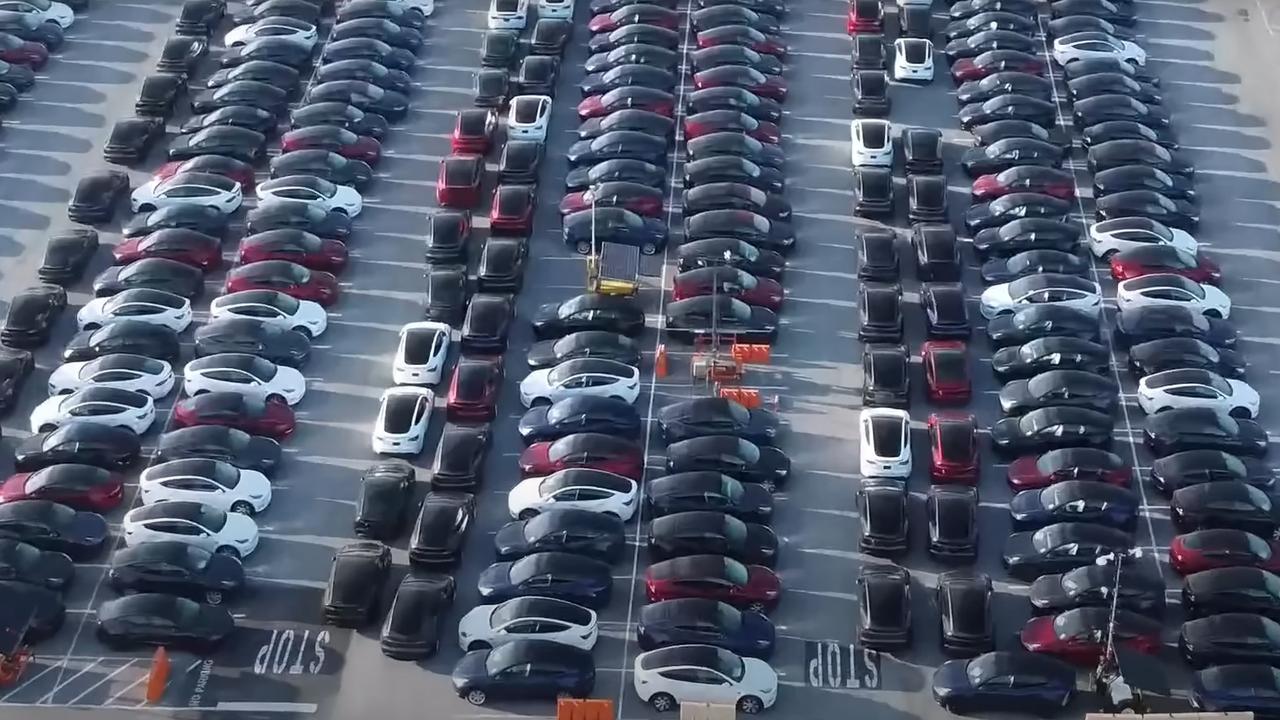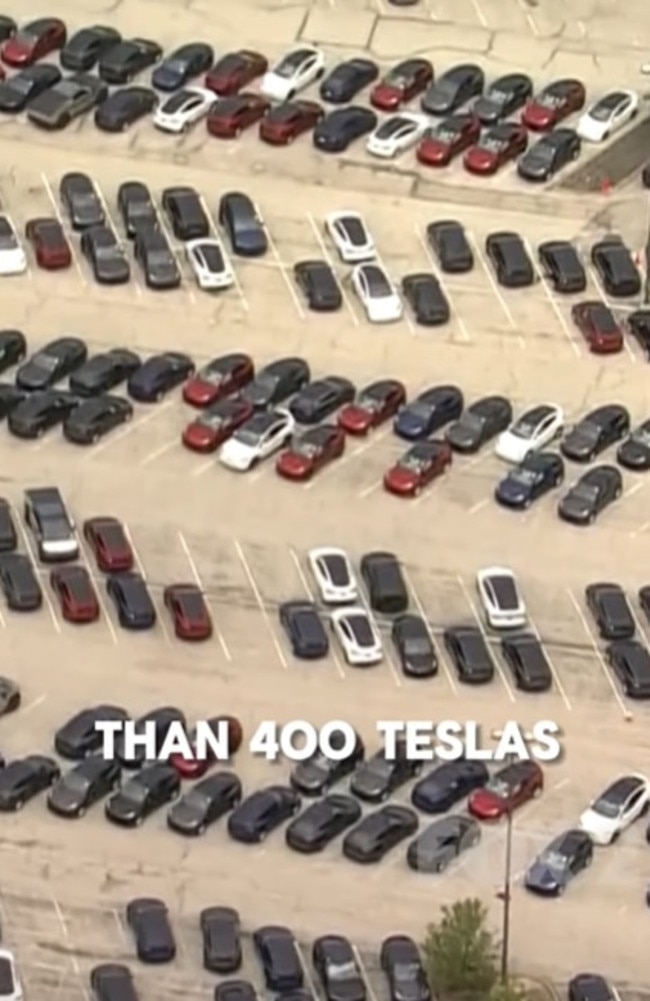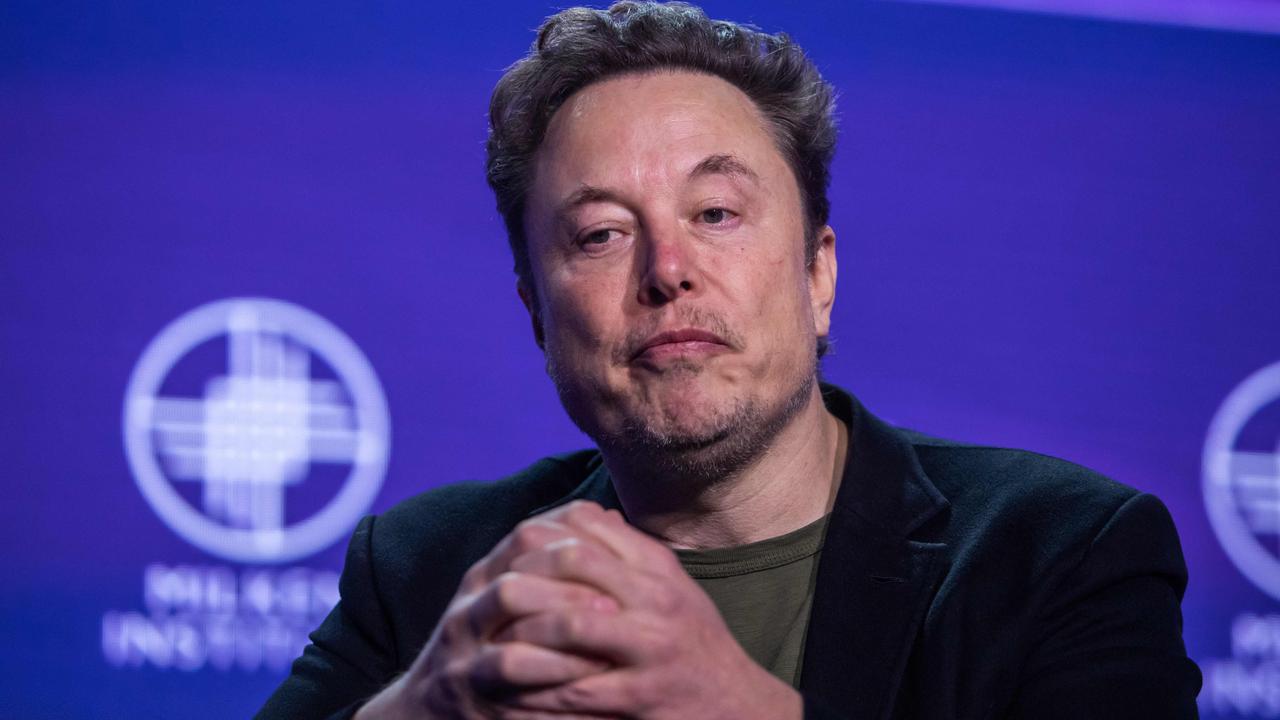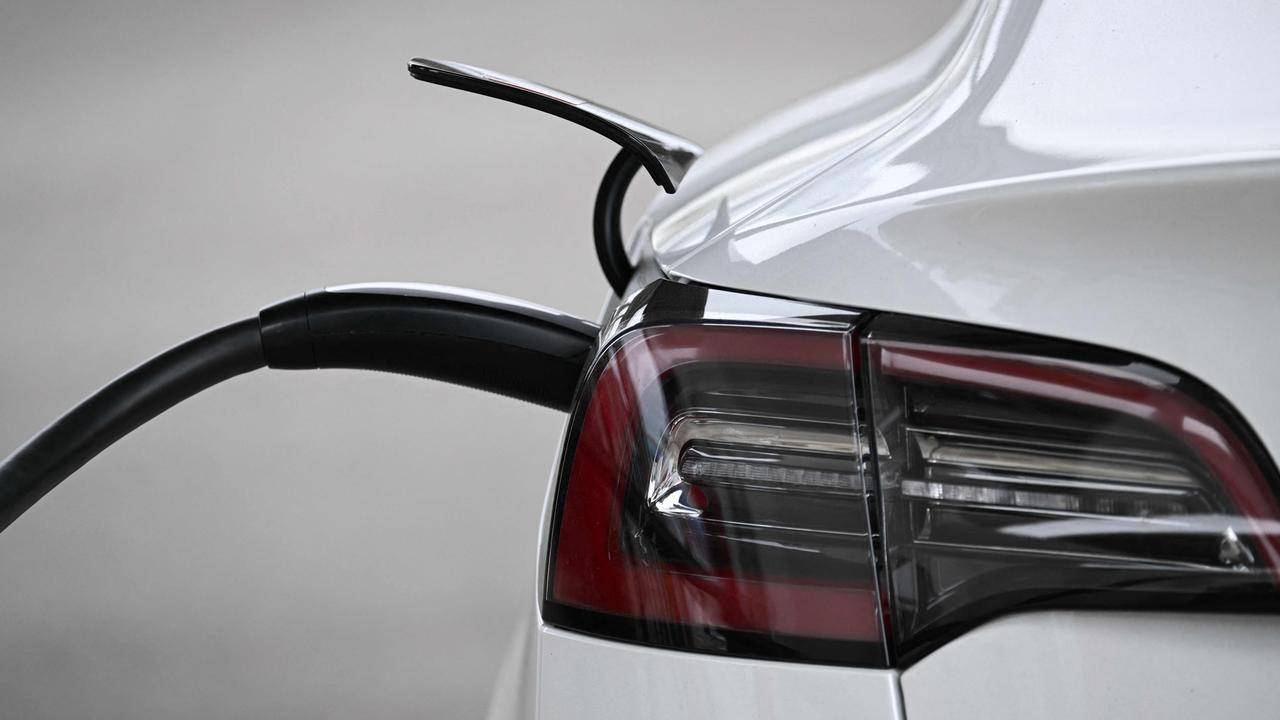‘What the hell?’: Tesla renting shopping centre, airport car parks as unsold EVs pile up
Stunning images have revealed the scale of the challenge facing troubled electric carmaker Tesla.
On the Road
Don't miss out on the headlines from On the Road. Followed categories will be added to My News.
Tesla is renting out shopping centre car parks to store unsold models as the electric carmaker faces flagging consumer demand and growing competition from cheaper Chinese rivals.
First-quarter sales figures released by Tesla last month revealed it produced 433,371 vehicles in the first three months of 2024 but delivered 386,810 — a whopping 8.5 per cent decline compared with the same period last year.
In the first three months of 2023, Tesla produced 440,808 vehicles and delivered 422,875, a difference of 17,993. In the first three months of 2024, Tesla produced 46,561 more vehicles than it delivered.
April car sales data from Australia showed a similar decline for the once-dominant brand as hybrid and plug-in hybrid demand outpaced EVs.
EV sales were down 5.1 per cent compared with April 2023 to 6194 sales, according to VFACTS, led by a massive 43.5 per cent year-on-year drop in Tesla sales to 2077 vehicles.
Despite reporting a 55 per cent drop in quarterly earnings to $US1.1 billion, reflecting the decline in EV sales, and announcing a massive round of lay-offs, the troubled carmaker shows no signs of slowing down its assembly lines.

Running out of space
Recent drone footage from its Fremont, California factory shows new cars continuing to fill up its vast parking lots, and Tesla is now being forced to find extra space to cope with the overflow, as Jalopnik notes.
In Chesterfield, about 40 kilometres from St. Louis, Missouri, around 400 Teslas — including dozens of Cybertrucks — have been spotted parked outside the Chesterfield Mall, which is due to close its doors in August.
“What the hell are they doing there?” one local asked on FOX 2 St. Louis.
The shopping centre owners, seeking to squeeze as much money out of the location as they can before it is demolished to make way for a mixed-use development, have leased the unused parking space to a nearby Tesla dealership.
“[Tesla] does not have enough capacity at the dealership to park all of the cars they are bringing in,” Tim Lowe, senior vice president of leasing and development for The Staenberg Group, told FOX 2. “So they are renting space within the parking lot to store their cars.”
Over in Germany, where Tesla’s only European factory is located near the town of Gruenheide about an hour southeast of Berlin, residents in nearby Neuhardenberg have complained about the traffic noise and disruption from columns of trucks delivering Teslas to be stored in the parking lot at the regional airport.
Local media report that the trucks thunder across the quiet rural roads several times an hour on their way to the airport, which has been used as Tesla storage since mid last year with the contract set to run until at least June.
Ronny Lenssen, who runs a farmhouse wedding venue next to the country road, told German public broadcaster RBB in January that a truck carrying three Teslas had recently interrupted a wedding ceremony after driving past with an alarm system blaring.
“The alarm system was on and the trunk lid of the lower one was open,” he said.

German factory to expand
The German factory was the scene of wild protests in recent days from residents and environmental activists opposed to its expansion.
Tesla announced on Thursday that its application to extend the production site had been approved, saying it was “extremely pleased” local officials in Gruenheide had voted in favour of the plan.
The plant opened in 2022 at the end of a tumultuous two-year approval and construction process. The carmaker had to clear a series of administrative and legal hurdles before production could begin at the site, including complaints from locals about the site’s environmental impact.
Plans to double capacity to produce a million cars a year at the site, which employs some 12,000 people, were announced in 2023.
The plant, which already occupies around 300 hectares, was set to be expanded by a further 170 hectares. But Tesla had to scale back its ambitions to grow the already massive site after locals opposed the plan in a non-binding poll.
Their concerns included deforestation required for the expansion, the plant’s high water consumption, and an increase in road traffic in the area.
In the new proposal, Tesla has scrapped plans for logistics and storage centres and on-site employee facilities, while leaving more of the surrounding forest standing.
Thursday’s council vote in Gruenheide drew strong interest from residents and was picketed by protesters opposing the extension, according to German media.
Protests against the plant have increased since February, and in March the plant was forced to halt production following a suspected arson attack on nearby power lines claimed by a far-left group.
Activists have also built makeshift tree houses in the woodland around the factory to block the expansion, and environmentalists gathered earlier this month in their hundreds at the factory to protest the enlargement plans.

‘Next phase of growth’
In a memo to staff last month announcing the “difficult decision” to sack more than 10 per cent of the workforce, Tesla boss Elon Musk insisted the company was preparing for the “next phase of growth”.
Tesla employs around 140,000 people, meaning at least 14,000 employees will be let go.
“Over the years, we have grown rapidly with multiple factories scaling around the globe,” Musk said in the memo obtained by Electrek.
“With this rapid growth there has been duplication of roles and job functions in certain areas. As we prepare the company for our next phase of growth, it is extremely important to look at every aspect of the company for cost reductions and increasing productivity.
“As part of this effort, we have done a thorough review of the organisation and made the difficult decision to reduce our headcount by more than 10 per cent globally. There is nothing I hate more, but it must be done. This will enable us to be lean, innovative and hungry for the next growth phase cycle.
“I would like to thank everyone who is departing Tesla for their hard work over the years. I’m deeply grateful for your many contributions to our mission and we wish you well in your future opportunities. It is very difficult to say goodbye.
“For those remaining, I would like to thank you in advance for the difficult job that remains ahead. We are developing some of the most revolutionary technologies in auto, energy and artificial intelligence. As we prepare the company for the next phase of growth, your resolve will make a huge difference in getting us there.”
Days later, Musk said Tesla would invest more than $US500 million ($750 million) this year to install new superchargers, despite reports of massive lay-offs in this branch of the company.
“Just to reiterate: Tesla will spend well over $500M expanding our Supercharger network to create thousands of NEW chargers this year,” Musk said on X. “That’s just on new sites and expansions, not counting operations costs, which are much higher.”
According to tech news outlet The Information, Tesla was moving to disband its supercharger department, laying off most of its 500 workers as well as its senior director, in the latest round of cuts.
The revelation raised questions about the future development of Tesla’s network of more than 50,000 fast chargers — the most extensive in the world, according to Tesla — which can add 320 kilometres of range in a quarter of an hour.
The fear of insufficient charging infrastructure is one of the reasons why sales of electric vehicles are progressing less rapidly than expected in the US and Tesla’s well developed network was seen as key to reassuring customers.
In early 2023, several competitors — Ford, General Motors and Rivian — entered into partnerships with Tesla so that their vehicles could use its fast-charging network in Canada and the United States.
A few weeks later, seven automakers — BMW, General Motors, Honda, Hyundai, Kia, Mercedes-Benz, Stellantis — announced the creation of a joint venture to install, from the middle of this year, at least 30,000 fast chargers in North America, accessible to all electric vehicles.

Gas guzzlers in the firing line
It comes as Australia’s crackdown on gaz-guzzling utes and SUVS gets the green light, after the Albanese government struck a deal with The Greens to pass its new emissions standards legislation.
The New Vehicle Efficiency Standard (NVES), set to take effect on January 1, 2025, will put caps on total carbon emissions permitted across a manufacturer’s fleet, meaning they will be required to sell a greater proportion of cleaner, greener vehicles like EVs and hybrids or face penalties.
The legislation passed the House of Representatives with the surprise support of Greens MPs on Thursday morning and is now expected to sail through the Senate.
Climate Council chief executive Amanda McKenzie celebrated the news, describing it as a “win for the climate, a win for our health, and a win for all Australians — whether they drive a car or not”.
“Australia has locked up the garage for good when it comes to expensive, polluting cars,” Ms McKenzie said.
“This law will see Australia slash climate pollution from one of our biggest sources, steering the transport sector towards a cleaner future. We look forward to seeing the positive impacts this important change will have on our hip-pockets, our health, and our environment.”
This week’s federal budget included nearly $155 million to get the NVES up and running, including $60 million to support the installation of electric vehicle charging infrastructure at car dealers.
“The Australian automotive industry is on the verge of a major transition with the commencement of the NVES in 2025,” said Australian Automotive Dealer Association (AADA) chief executive James Voortman.
“It is critical that our budget settings support this transition by encouraging the uptake of low-emissions vehicles, reforming automotive taxation and investing in skills and infrastructure. There are massive investments required by our industry to transition to net zero and the government should consider measures to encourage those investments.”
— with AFP
Originally published as ‘What the hell?’: Tesla renting shopping centre, airport car parks as unsold EVs pile up









